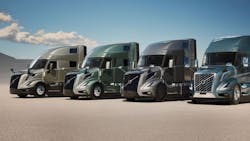Volvo’s Lundstedt: ‘We are in good balance’ between orders and production
Key takeaways:
- Volvo has achieved a balance between supply and demand in North America while continuing to adjust production due to weak equipment demand.
- North American sales fell 18% in Q2 to about $3.7 billion, with truck orders also experiencing a significant decline.
- Despite the challenges, Volvo remains optimistic about its future performance, thanks to new vehicle lineups that enhance competitiveness.
The president and CEO of Volvo Group said his team has found an equilibrium between supply and demand in North America as many of the original equipment manufacturer’s customers continue to be in “a wait-and-see mood.”
Volvo leaders this spring laid off hundreds of workers at locations in Pennsylvania, Virginia, and Maryland, citing high uncertainty in the market due to freight demand and tariffs being imposed or contemplated by the administration of President Donald Trump. Speaking July 18 after reporting second-quarter results, Martin Lundstedt said his teams are continuing to adjust production levels to account for weak demand for equipment from carriers who have, as DAT Freight & Analytics Chief of Analytics Ken Adamo said last week, seen their volumes move “in fits and starts rather than steadily and predictably building toward the July 4 holiday.”
On a conference call with analysts, Lundstedt said Volvo has found sounder footing of late as it has adjusted to the weak market and to the one-time effects of an aggressive launch program of Volvo and Mack vehicles that temporarily took a bite out of its market share.
“We feel now […] that we are in good balance,” he said. “And […] we feel that our order intake is gradually coming back.”
That’s not to say the overall level of uncertainty has dissipated, though. Lundstedt noted that cloudiness persists around the fate of proposed 2027 emissions regulations, the comings and goings of tariffs, and the broader economic picture. As a result, he added, Volvo leaders are prepared to “continue to adjust if necessary.”
Volvo’s North American sales, including those from its construction equipment, bus, and industrial divisions, fell 18% in the second quarter to about $3.7 billion. The company delivered nearly 13,000 trucks in the region, including 8,191 Mack vehicles—the latter lifting that brand’s market share by more than a point to 7.2%. Globally, Volvo delivered 52,764 vehicles, which was a drop of 10% from Q2 of 2024.
Total truck orders for the region fell 18% to 8,243, with Mack’s number falling by more than a third from the spring of 2024 to 4,277. Lundstedt said he’s optimistic Volvo can hold its own in the market now, thanks to recent lineup additions such as the Volvo VNL and VNR as well as the Mack Anthem and Pioneer models.
Shares of Volvo (Ticker: VLVLY) closed last week at $26.66, down more than 6% from the previous Friday. They are, however, still up 4% over the past six months, a gain that has grown the company’s market capitalization to about $54 billion.
About the Author
Geert De Lombaerde
Senior Editor
A native of Belgium, Geert De Lombaerde has more than two decades of experience in business journalism. Since 2021, he has written about markets and economic trends for Endeavor Business Media publications FleetOwner, Healthcare Innovation, IndustryWeek, Oil & Gas Journal, and T&D World.
With a degree in journalism from the University of Missouri, he began his reporting career at the Business Courier in Cincinnati. He later was managing editor and editor of the Nashville Business Journal. Most recently, he oversaw the online and print products of the Nashville Post and reported primarily on Middle Tennessee’s finance sector and many of its publicly traded companies.




